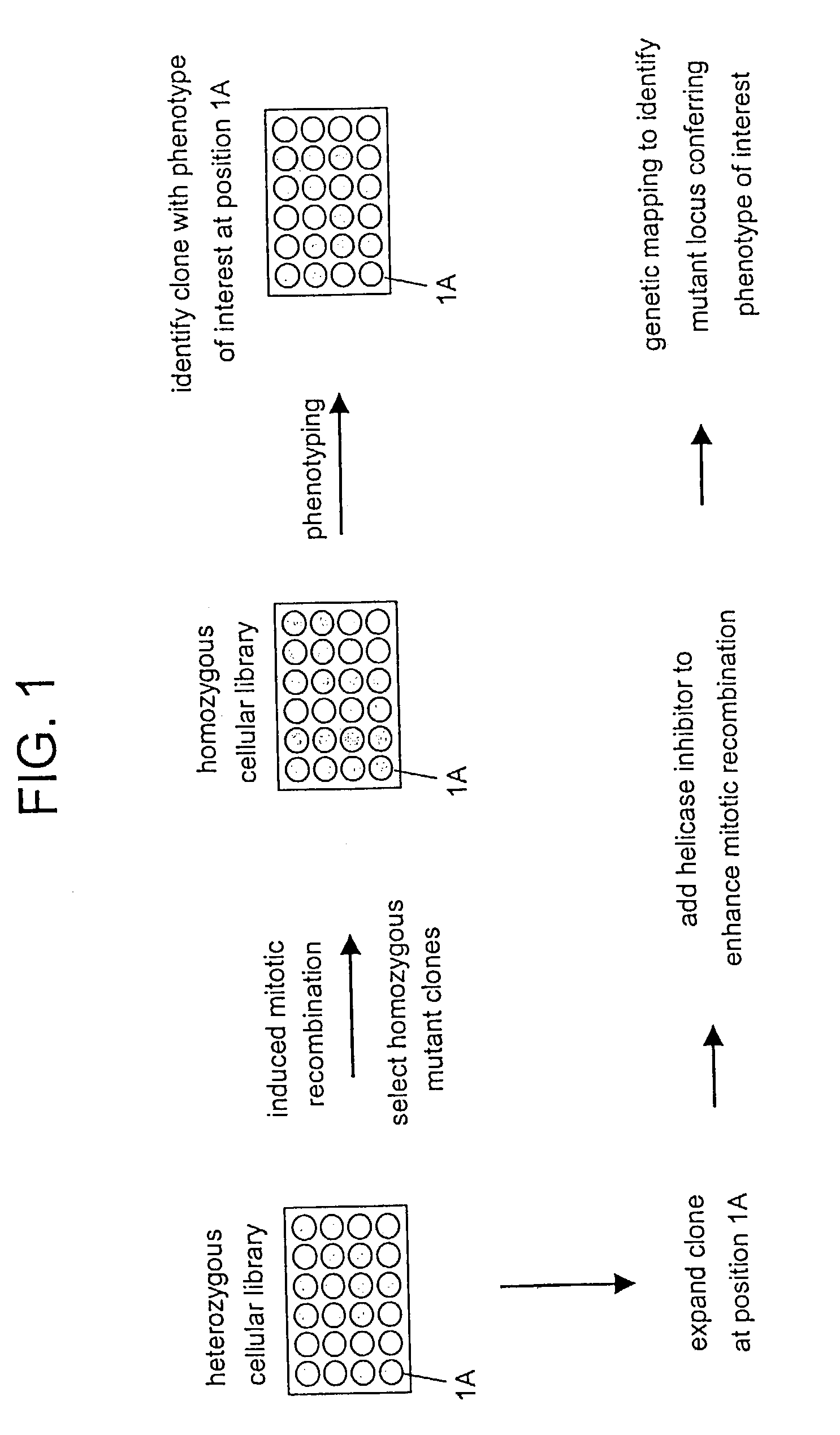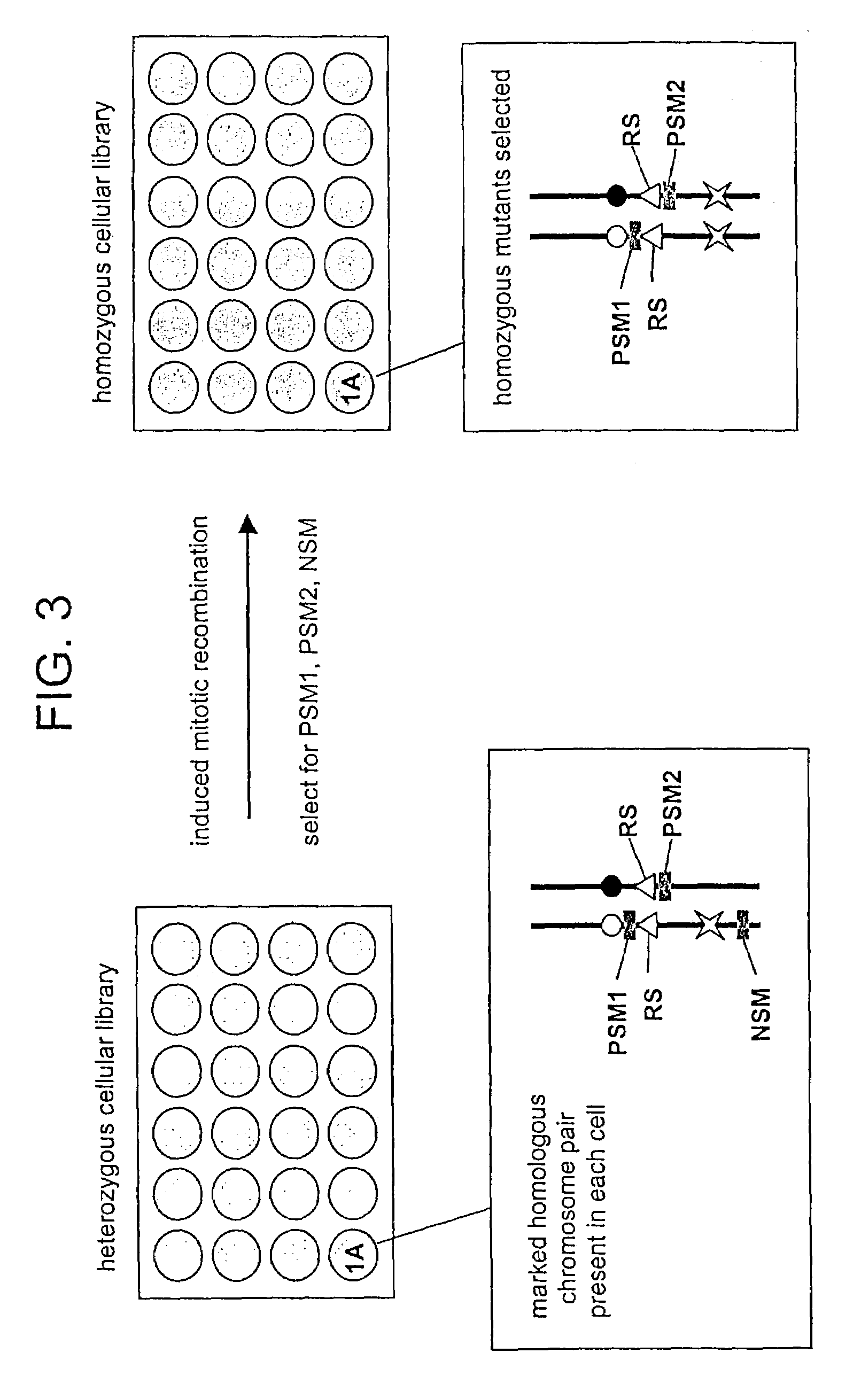In Vitro mutagenesis, phenotyping, and gene mapping
a mutagenesis and in vitro technology, applied in the field of in vitro mutagenesis, phenotyping, and gene mapping, can solve the problems of loss of gene function, limited systematic mutagenesis studies, and inability to use functional genomics approaches in most organisms
- Summary
- Abstract
- Description
- Claims
- Application Information
AI Technical Summary
Problems solved by technology
Method used
Image
Examples
example 1
Preparation of ES Cells Comprising Marked Chromosomes
[0270]Non-recombinant inbred mouse strains C57BL / 6J and 129S8 / SvEv@J-GpilcHprtb−m2 are crossed. ES cells are isolated from the resulting F1 progeny and maintained in an undifferentiated state by culturing them on a feeder cell layer.
[0271]Gene targeting methods were used to prepare ES cells comprising a pair of allelic recombination cassettes and a distal chromosome marker. A targeting vector p[Puror lox71] was prepared comprising a [Puror lox71] flanked by genomic sequences at the C57BL / 6J D4Mit149 locus. A targeting vector p[lox66β-geo] was prepared comprising a [lox66β-geo] recombination cassette flanked by genomic sequences at the 129S8 / SvEv@J-GpilcHprtb−m2 D4Mit149 locus. A targeting vector comprising a distal chromosome marker was prepared using an HPRT cDNA flanked by genomic sequence at the C57BL / 6J D4Mit51 locus. The targeting vectors were sequentially electroporated into ES cells essentially as described by Stevens, 1983...
example 2
Preparation of a Heterozygous Cellular Library
[0272]ES cells comprising a marked chromosome pair are prepared as described in Example 1. Cells are grown in MEM culture medium supplemented with 15% heat-inactivated fetal calf serum, 1000 units / ml leukemia inhibitory factor (LIF), and 10 μM β-mercaptoethanol. Cells are grown on 100-mm petri dishes and cultured at 37° C. in a humidified atmosphere of 5% CO2 in air. For subculturing, cells are dissociated in Hank's Balanced Salt Solution (HBSS) containing 0.25% trypsin and 0.02% ethylene diamine tetraacetic acid (EDTA). Following a 3-minute incubation at room temperature, dissociated cells are resuspended in culture medium, and the number of cells is determined using a hemocytometer. Culture media and supplements are available from Invitrogen Corp., Carlsbad, Calif., United States of America.
[0273]Plating efficiency is determined by determining the percentage of viable cells in mature cultures. Briefly, cells are plated at a density of ...
example 3
Storage of Cellular Libraries
[0277]Cellular libraries and replica cellular libraries are preserved by storage in a cryopreservation medium at or below −70° C. Cryopreservation media generally consists of a base medium, a cryopreservative, and a protein source. The cryopreservative and protein protect the cells from the stress of the freeze-thaw process. For serum-containing medium, a typical cryopreservation medium is prepared as complete medium containing 10% glycerol; complete medium containing 10% DMSO (dimethylsulfoxide), or 50% cell-conditioned medium with 50% fresh medium with 10% glycerol or 10% DMSO. For serum-free medium, typical cryopreservation formulations include 50% cell-conditioned serum free medium with 50% fresh serum-free medium containing 7.5% DMSO; or fresh serum-free medium containing 7.5% DMSO and 10% cell culture grade DMSO. A cell suspension typically comprises about 106 to about 107 cells per ml is mixed with cryopreservation medium. Cellular libraries compr...
PUM
| Property | Measurement | Unit |
|---|---|---|
| temperature | aaaaa | aaaaa |
| permeable | aaaaa | aaaaa |
| resistance | aaaaa | aaaaa |
Abstract
Description
Claims
Application Information
 Login to View More
Login to View More - R&D
- Intellectual Property
- Life Sciences
- Materials
- Tech Scout
- Unparalleled Data Quality
- Higher Quality Content
- 60% Fewer Hallucinations
Browse by: Latest US Patents, China's latest patents, Technical Efficacy Thesaurus, Application Domain, Technology Topic, Popular Technical Reports.
© 2025 PatSnap. All rights reserved.Legal|Privacy policy|Modern Slavery Act Transparency Statement|Sitemap|About US| Contact US: help@patsnap.com



